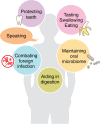Cancer therapy-related salivary dysfunction
- PMID: 39225092
- PMCID: PMC11364403
- DOI: 10.1172/JCI182661
Cancer therapy-related salivary dysfunction
Abstract
Salivary gland dysfunction is a common side effect of cancer treatments. Salivary function plays key roles in critical daily activities. Consequently, changes in salivary function can profoundly impair quality of life for cancer patients. We discuss salivary gland anatomy and physiology to understand how anticancer therapies such as chemotherapy, bone marrow transplantation, immunotherapy, and radiation therapy impair salivary function. We discuss approaches to quantify xerostomia in the clinic, including the advantages and limitations of validated quality-of-life instruments and approaches to directly measuring salivary function. Current and emerging approaches to treat cancer therapy-induced dry mouth are presented using radiation-induced salivary dysfunction as a model. Limitations of current sialagogues and salivary analogues are presented. Emerging approaches, including cellular and gene therapy and novel pharmacologic approaches, are described.
Conflict of interest statement
Figures



References
-
- López-Pintor RM, et al. Xerostomia and hyposalivation. In: Hogue CM, Ruiz JG, eds. Oral Health and Aging. Cham: Springer International Publishing; 2022:85–108.
Publication types
MeSH terms
Substances
Grants and funding
LinkOut - more resources
Full Text Sources
Medical

